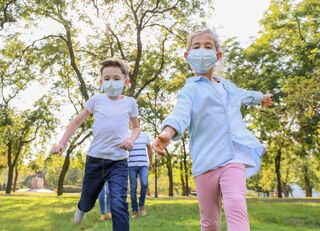When I was a kid, my parents constantly told me to go play outside. I lived in a town where kids knocked on each other’s doors to ask if their friends could “come out and play,” rode their bikes in the street, and sat on their front steps together to eat ice cream cones after dinner in the summertime. When I was a kid, kids spent a lot of time playing outside.

But things have changed significantly for kids in the past 30-40 years. Playtime is on the decline, especially outdoor play. Between the years of 1981 and 1997, research suggests, unstructured playtime dropped by about 25 percent (Hofferth & Sandberg, 2001), and a more recent survey of nearly 9,000 families with preschool-aged children in the United States indicated that about half do not go outside to play regularly (Tandon, Zhou, & Christakis, 2012).
This decline seems to be happening for a number of reasons. Children are spending more time in structured activities in schools and daycares (Hofferth & Sandberg, 2001), and as a result, recess time is decreasing. In fact, a survey of U.S. schools suggests that only 40 percent of schools have a designated policy for outdoor play (Burriss & Burriss, 2011). On top of that, parents are working more, leaving less time to monitor their kids when they are playing outside. And children are spending more time on screens, often saying that they prefer electronic games to playing outside (Dowdell, Gray, & Malone, 2011).
Why the Decline in Outdoor Play Matters
Researchers, pediatricians, and parents alike have expressed concern about these trends. Indeed, the American Academy of Pediatrics recommends that children play outside as much as possible. This is because outdoor play carries a number of benefits for kids. First and foremost, playing outside is related to more physical activity, which is good for children’s overall health, and can even help fight against childhood obesity and cardiovascular disease (Tandon, Zhou, & Christakis, 2012). And while it’s true that children can play physically while they’re indoors and even at school, research indicates that playing outdoors where children are free to choose their own fun is where the most physical activity is likely to happen (Burdette & Whitaker, 2005).
Besides physical development, outdoor play also seems to carry benefits for children’s cognitive development and learning. For example, when children spent a lot of time in school, they need time to recover from structured activities so that they can come back to the classroom ready to learn. Accordingly, research suggests that after recess, children are more focused and less fidgety (Burriss & Burriss, 2011). On top of that, contact with the natural elements can provide a context for learning about science and nature. In fact, when children engage in outdoor activities, they are more likely to express interest in protecting the environment (Bento & Dias, 2017).
Finally, playing outside can also have benefits for children’s social and emotional development. When children are playing outside on their own, they have the opportunity to organize their own games and settle disagreements, which involves cooperation and perspective-taking. On top of that, it can help them build friendships, which is important for the development of social competence and prosocial behaviors like helping and sharing. The friendships they make when playing outside can be important for children’s overall long-term happiness, and physical activity in general is linked to overall well-being and can act as a buffer against depression (Burdette & Whitaker, 2005).
Making a Push for Outdoor Play
Overall, it’s pretty clear that playing outside has a lot of benefits for kids. But, finding time to play outside is easier said than done. As mentioned above, parents are working more, and there are usually more concerns about safety when it comes to playing outside versus inside where kids don’t have to be monitored as much. This is a particular concern for families living in high-poverty areas who may be especially nervous for their children’s safety (Kimbro & Schachter, 2011). As a result, finding and perhaps developing safe outdoor play spaces for all children is key.
A famous biologist and naturalist, E. O. Wilson, proposed that all human beings have a natural connection with the outdoors, and whether we realize it or not, engaging with nature may be important for our mental health (Wilson, 1984). Now that spring is here, we have the opportunity to nurture that connection by spending more time outside with our kids. Especially given recent COVID-19 restrictions on indoor activities, taking time to be together outside (while taking necessary precautions) is more important than ever. So, this week, take a minute to stop and smell the roses; let your children play in the spring grass, knowing that it will help rejuvenate their minds and bodies, and even promote those much-needed connections with nature and with each other.
Original post: https://www.psychologytoday.com/us/blog/the-baby-scientist/202104/the-benefits-playing-outside